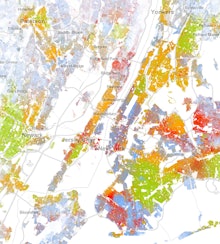How Segregated Are America's Cities? Check These Eye-Opening Maps

Image Credit (all): Cooper Center
America is more divided than you thought. In a week that's seen racial tensions go through the roof in Missouri over the death of black teenager Mike Brown, it's important to remember that the United States remains highly geographically segregated on race and class lines.
This sweeping national view courtesy of the Racial Dot Map (click in for an interactive version), created by the Demographics Research Group's Dustin Cable, shows that all across the U.S. whites, blacks, Latinos, Asians and other racial groups all tend to live in relative isolation from one another. Hispanic people predominantly live in the Southwest, while black people tend to live in the South or in the urban core of bigger cities across the north and Midwest.
These geographic populations are the result of long-term historical trends and reflect current-day inequities between racial groups in modern America. Zoom in to the city level and another clear pattern emerges — non-whites tend to be relegated to poorer areas. Just take New York City, where decades of racial segregation has solidified white populations in the richest neighborhoods and blacks and Hispanics in the other ones (and a similar pattern is ubiquitous throughout the region):
Or look at Los Angeles, where Salon's Daniel Denvir writes "jobless ghettos of black and Latino Los Angeles remain" two decades after the 1992 L.A. riots, while "safe in their cars and behind their gates, most white people have gone back to not paying attention."
Or Philadelphia, where urban renewal operations razed entire black neighborhoods like Black Bottom:
Big coastal cities only paint part of the picture. Here's Chicago:
And Atlanta:
St. Louis County, where Ferguson is located, is in one of the most segregated areas in the country. Ferguson is located just to the southwest of Black Jack:
Not every American city is this highly segregated, but most of them are. This snapshot of the Population Reference Bureau's 2011 list of the most and least racially divided cities shows that most of the country's largest metros are highly segregated.
Image Credit: PRB
Fortunately, there are good signs that other rapidly growing cities aren't repeating the mistakes of the past.
The PRB reports that the least segregated cities are mostly in areas of high population growth in the (generally not deep) South and West, like Tucson, Las Vegas-Paradise, Charleston, Phoenix-Mesa-Glendale and Colorado Springs.
"The ghettoes of the Northeast and Midwest are not being reconstituted in the fast-growing areas of the South and West," Penn State University demographer John Iceland noted in the PRB report. Reynolds Farley, a University of Michigan sociology professor, added that, "The long trend toward lower levels of black-white segregation" in the past few decades "seems sure to continue," though desegregation is happening at a relatively slow pace.
So that's one upshot: American cities will one day be much more racially intermixed, even if it will take most of the 21st century to get there.
h/t Cooper Center